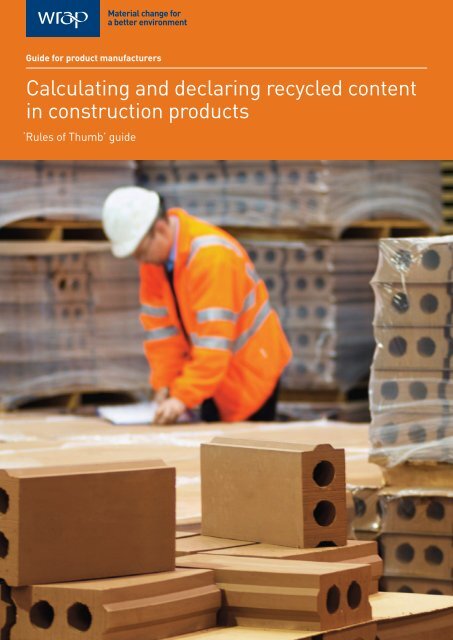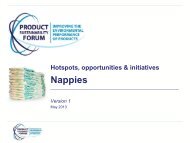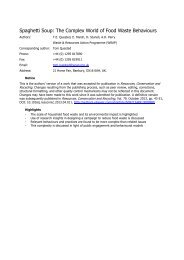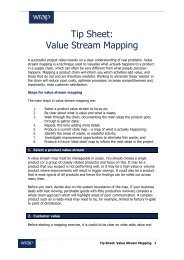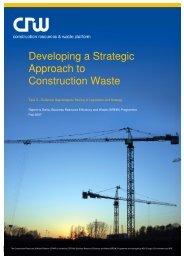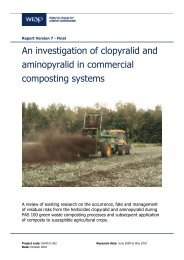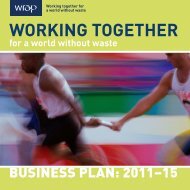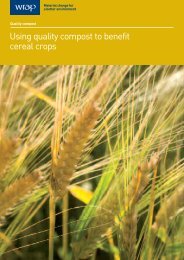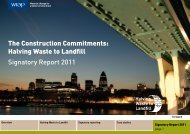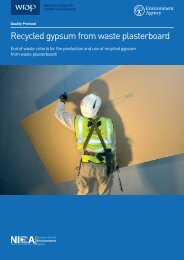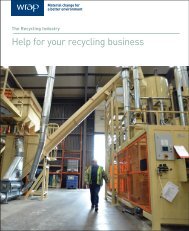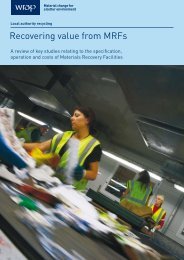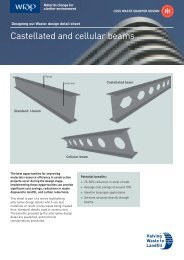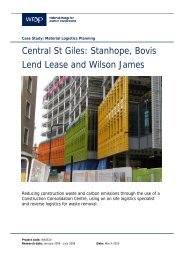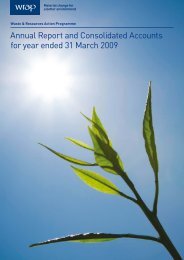Create successful ePaper yourself
Turn your PDF publications into a flip-book with our unique Google optimized e-Paper software.
Guide for product manufacturers<br />
Calculating and declaring recycled content<br />
in construction products<br />
‘<strong>Rules</strong> <strong>of</strong> <strong>Thumb</strong>’ <strong>guide</strong>
WRAP works in partnership to encourage<br />
and enable businesses and consumers to<br />
be more efficient in their use <strong>of</strong> materials<br />
and recycle more things more <strong>of</strong>ten. This<br />
helps to minimise landfill, reduce carbon<br />
emissions and improve our environment.<br />
The term ‘rule <strong>of</strong> thumb’ or similar stands in many languages and<br />
cultures for ‘quickly understood, easily used, practical method’.
Calculating and declaring recycled content in construction products 01<br />
Introduction<br />
Construction clients and planning authorities are increasingly setting requirements<br />
to encourage greater use <strong>of</strong> recovered materials within construction projects. WRAP<br />
(Waste & Resources Action Programme) have been promoting and facilitating this trend<br />
as one contribution to waste reduction, reuse and recycling.<br />
In order to assess contributions to the recycled content by value <strong>of</strong> a building or infrastructure,<br />
design teams need to know the recycled content by mass <strong>of</strong> products – particularly when<br />
looking at options to substitute one brand with another brand <strong>of</strong> the same type <strong>of</strong> product<br />
within the chosen design specification. Data are therefore needed on a brand by brand basis<br />
and must be able to be calculated and recorded on product data sheets in a clear and consistent<br />
fashion. A recent European standard identifies recycled content as part <strong>of</strong> an environmental<br />
product declaration 1 .<br />
The aim <strong>of</strong> this Guide is to provide a set <strong>of</strong> ‘<strong>Rules</strong> <strong>of</strong> <strong>Thumb</strong>’ for the calculation and declaration<br />
<strong>of</strong> recycled content in construction products. It should add clarity and consistency to the way<br />
such data are calculated and reported and clarify some situations where interpretation has<br />
been required in the past. The <strong>guide</strong> has been developed for WRAP by BRE in consultation with<br />
product manufacturers and their trade associations.<br />
Who is taking action?<br />
Various organisations have set requirements for reused and recycled content on their projects,<br />
including:<br />
■ British Land, Hammerson and Stanhope;<br />
■ John Lewis Partnership and Marks & Spencer;<br />
■ Skanska and Carillion;<br />
■ Olympic Delivery Authority;<br />
■ Scottish Government;<br />
■ Welsh Assembly Government;<br />
■ Northern Ireland Central Procurement Directorate;<br />
■ Yorkshire Forward;<br />
■ Welsh Health Estates;<br />
■ Hillingdon and Bristol Southmead hospitals;<br />
■ Defence Estates;<br />
■ Building Schools for the Future;<br />
■ National Offender Management Service;<br />
■ Raploch Urban Regeneration Company;<br />
■ Leeds Metropolitan University; and<br />
■ Aberdeen, Bristol, Glasgow, Leeds, Newcastle and Sheffield City Councils.<br />
Typically, a requirement may be worded as follows:<br />
‘… at least 10% <strong>of</strong> the total value <strong>of</strong> materials used should derive from recycled and reused content<br />
in the products and materials selected. In addition, show that the most significant opportunities to<br />
increase the value <strong>of</strong> materials derived from recycled and reused content have been considered,<br />
such as the top ten Quick Wins or equivalent, and implement good practice where technically and<br />
commercially viable.’<br />
This focuses contractors onto identifying a limited number <strong>of</strong> product substitutions within their<br />
chosen design, and finding cost-competitive alternative brands and materials currently<br />
available on the market.<br />
1 See International Standard ISO 21930: 2007 Sustainability in building construction – Environmental declaration <strong>of</strong> building products.
02 Calculating and declaring recycled content in construction products<br />
Guiding principles<br />
Whilst recycled content is a single indicator and cannot address all <strong>of</strong> the issues surrounding<br />
sustainability and environmental impact, this Guide was produced with the following guiding<br />
principles in mind:<br />
1. resource efficiency – use fewer virgin materials;<br />
2. send less to landfill and close the loop by reusing waste materials;<br />
3. discourage wasteful or inefficient processing;<br />
4. reduce environmental impact wherever possible; and<br />
5. recognise commercial as well as environmental drivers.<br />
Across all the ‘Quick Win’ product categories where higher recycled content can commonly<br />
be found at competitive cost and where sufficient data exist for conclusions to be drawn,<br />
on average, selecting options with higher recycled content within a category achieves lower<br />
overall environmental impact 2 . However, it must be recognised that higher recycled content<br />
in an individual product does not always guarantee a lower impact.<br />
Standards and legislative framework<br />
This <strong>guide</strong> works within and is compliant to ISO 14021 and uses its definition <strong>of</strong> recycled<br />
content while <strong>of</strong>fering a calculation which takes into account the yield <strong>of</strong> any input in relation<br />
to the final product.<br />
ISO 14021 defines recycled content as “the proportion, by mass, <strong>of</strong> recycled material in a<br />
product or packaging. Only pre-consumer and post-consumer materials shall be considered<br />
as recycled content, consistent with the following usage <strong>of</strong> the terms:<br />
■ Pre-consumer material:<br />
Material diverted from the waste stream during a manufacturing process. Excluded is<br />
reutilization <strong>of</strong> materials such as rework, regrind or scrap generated in a process and<br />
capable <strong>of</strong> being reclaimed within the same process that generated it.<br />
■ Post-consumer material:<br />
Material generated by households or by commercial, industrial and institutional facilities in<br />
their role as end-users <strong>of</strong> the product, which can no longer be used for its intended purpose.<br />
This includes returns <strong>of</strong> material from the distribution chain.”<br />
For the purposes <strong>of</strong> the calculation, the term ‘product’ refers to the final product as delivered<br />
to the construction site and incorporated in the works. So, for example, ready-mixed concrete<br />
will be set and composite products will be as finally assembled.<br />
Recycling in the technical legal sense, for the purposes <strong>of</strong> the Packaging Directive and by<br />
extension also to other wastes is: “Reprocessing in a production process <strong>of</strong> the waste materials<br />
for the original purpose or for other purposes including organic recycling but excluding energy<br />
recovery”. Therefore the term “recycled” carries the meaning <strong>of</strong> a waste that has been through<br />
a production process and is destined for use. 3<br />
Declaration <strong>of</strong> recycled content<br />
This <strong>guide</strong> has been produced with a view to manufacturers self-declaring the recycled content<br />
<strong>of</strong> their products based on the calculation and criteria laid out below, but each manufacturer<br />
should ensure that any data in support <strong>of</strong> the declaration can be made available to an<br />
independent verifier or challenger. Declaration <strong>of</strong> recycled content should be included on<br />
standard product data sheets alongside other environmental and technical data. It is anticipated<br />
that certification bodies will be able to <strong>of</strong>fer a certification service based on this calculation to<br />
verify independently that the claims are correct.<br />
2 This is illustrated by BRE analysis for WRAP using life-cycle data and the BRE Ecopoints metric – see Environmental impact <strong>of</strong> higher recycled content in construction<br />
projects, WRAP, 2007.<br />
3 Personal communication, Environment Agency, 2007.
Calculating and declaring recycled content in construction products 03<br />
Link to other schemes and standards<br />
BRE Certification Environmental Pr<strong>of</strong>iles and the Green Guide<br />
The 2007 methodology for the BRE Certification Scheme for Environmental Pr<strong>of</strong>iles will use this<br />
calculation and the intention is that manufacturers will be able to request a certificate for this as<br />
part <strong>of</strong> the Environmental Pr<strong>of</strong>ile. This method has also been used for the calculations <strong>of</strong><br />
generic data in support <strong>of</strong> the 2007 Green Guide for Specification.<br />
British Board <strong>of</strong> Agrément (BBA)<br />
The BBA will use the <strong>Rules</strong> <strong>of</strong> <strong>Thumb</strong> to introduce a working procedure to allow a declaration<br />
<strong>of</strong> recycled content to be included within a Agrément Certificate for an existing or new<br />
construction product.<br />
The method <strong>of</strong> calculation<br />
M 1 Y 1 + M 2 Y 2 + M 3 Y 3 x 100 = recycled content %<br />
P<br />
where: M = mass <strong>of</strong> recycled input<br />
Y = yield <strong>of</strong> input (taking into account waste losses, moisture content, etc)<br />
P = mass <strong>of</strong> final product 4<br />
The ISO 14021 definition uses the term ‘proportion by mass <strong>of</strong> recycled material in a product<br />
or packaging’. In order to calculate the mass <strong>of</strong> the input that is actually in the final product,<br />
yield is used (see page 08).<br />
Note that for the purposes <strong>of</strong> the <strong>Rules</strong> <strong>of</strong> <strong>Thumb</strong>, recycled content within packaging<br />
is not included.<br />
Which materials can be included as recycled content?<br />
This Guide sets out four criteria for the acceptance <strong>of</strong> a material as recycled content within<br />
a construction product. A material needs only comply to any one <strong>of</strong> these criteria to secure<br />
its status as recycled content. Whilst compliance to any one is sufficient, where more than<br />
one criterion is satisfied, preference is given to criteria A and B in terms <strong>of</strong> justifying the<br />
material status.<br />
Note that aggregates subject to the Aggregates Levy cannot be classified as recycled content.<br />
Any claims for materials used in this context must be verifiable independently if required.<br />
The four criteria are shown overleaf.<br />
4 Note that P should be equal to the mass <strong>of</strong> all input materials multiplied by their yields.
04 Calculating and declaring recycled content in construction products<br />
Criterion A<br />
Any wastes 5 that are listed in the European Waste Catalogue<br />
Examples<br />
Recycled newspaper<br />
European Waste Catalogue reference: 20 01 01 ‘paper and cardboard’. Under section 20 for<br />
Municipal Wastes (Household waste and similar commercial, industrial and institutional<br />
wastes) including separately collected fractions.<br />
Newspapers are post-consumer waste and the use <strong>of</strong> recovered paper in a construction<br />
product would count as recycled content.<br />
PFA (pulverised fuel ash or fly ash)<br />
European Waste Catalogue reference: 10 01 01 ‘bottom ash, slag and boiler dust (excluding<br />
boiler dust mentioned in 10 01 04) or 10 01 02 ‘coal fly ash’. Under section 10 for Wastes<br />
from Thermal Processes.<br />
PFA is currently listed as a waste product and where this is recovered and used in a<br />
construction product, it can be included as recycled content.<br />
China clay sand<br />
European Waste Catalogue reference: 01 04 09 ‘waste sand and clays’. Under section 01 for<br />
Wastes Resulting from Exploration, Mining, Quarrying, and Physical and Chemical Treatment<br />
<strong>of</strong> Minerals.<br />
China clay waste is a mineral waste from the production <strong>of</strong> kaolin that can be processed<br />
to produce china clay sand, which as a recovered waste can be included as recycled content<br />
<strong>of</strong> a construction product.<br />
Criterion B<br />
Any material that is classified or intended to be classified as ‘waste’ within the ISO 14021<br />
definition stated previously. This includes post-construction waste and returns from the<br />
distribution chain.<br />
Example<br />
Waste gypsum<br />
Returns from a construction site <strong>of</strong> any unused plasterboard are classed as a return from<br />
the distribution chain and, once recovered from the waste stream, can therefore be included<br />
as recycled content.<br />
Criterion C<br />
Offcuts or scrap generated within a process where a recovery operation process is required<br />
prior to its re-use that changes the physical or chemical nature <strong>of</strong> the material, e.g. granulation<br />
<strong>of</strong> extruded plastic or crushing <strong>of</strong> waste blocks.<br />
Example<br />
Windows<br />
Window fabrication scrap can be ground, pulverized and blended before re-extrusion, so<br />
the recovery operation changes its physical nature to allow its re-use. This material does<br />
not need to have entered the distribution chain in order to be classed as recycled content<br />
in these circumstances.<br />
5 Note that a material does not necessarily or immediately cease to be a waste if sent for use in construction products – the point <strong>of</strong> recovery <strong>of</strong> a waste is a separate issue.
Calculating and declaring recycled content in construction products 05<br />
Criterion D<br />
By-products as defined by the EC Interpretative Communication on waste and by-products 6 .<br />
A by-product is defined as a production residue that is not a waste, and a production residue<br />
is defined as a material that is not deliberately produced in a production process but may or<br />
may not be a waste. In order to be considered a by-product, a production residue must satisfy<br />
all <strong>of</strong> the following three criteria 7 :<br />
■ the further use <strong>of</strong> the residue is not a mere possibility but a certainty;<br />
■<br />
■<br />
the residue does not need any further processing prior to re-use; and<br />
the residue is produced for further use as an integral part <strong>of</strong> a continuing process<br />
<strong>of</strong> production.<br />
For the calculation <strong>of</strong> recycled content within this document, if all three criteria are true, the<br />
production residue is probably not a waste, but is a by-product. See the decision tree on the<br />
following page (Fig. 1).<br />
Examples<br />
Blast Furnace Slag<br />
The Environment Agency (EA) issued a Position Statement in August 2007 which was<br />
informed by the Communication from the Commission on by-products and the Technical<br />
Report on Blast Furnace Slag produced by the EA/WRAP Waste Protocols Project. The<br />
Position Statement states that the EA is satisfied that BFS is a by-product and not waste.<br />
Calcium sulphite as contained within Flue Gas Desulphurised (FGD) Gypsum<br />
Calcium sulphite is a by-product <strong>of</strong> the coal fired power stations derived from the<br />
requirement to reduce the environmental impact <strong>of</strong> combustion through the neutralisation<br />
<strong>of</strong> the sulphur dioxide emissions. A further process <strong>of</strong> adding oxygen to the calcium sulphite<br />
is carried out to produce calcium sulphate (FGD gypsum), which can replace natural gypsum<br />
in construction products, notably plasterboard.<br />
In order to calculate the calcium sulphite content <strong>of</strong> FGD gypsum for the purposes <strong>of</strong> the<br />
calculation <strong>of</strong> recycled content, a standard factor <strong>of</strong> 88%, based on the molecular weights <strong>of</strong><br />
the FGD gypsum and the oxygen, should be applied to the mass <strong>of</strong> FGD gypsum being added,<br />
in any claim for recycled content.<br />
For example: if 0.8 tonnes <strong>of</strong> FGD gypsum is in a tonne <strong>of</strong> a product, 0.7 tonnes can be<br />
claimed as recycled content, where 0.8 x 88% = 0.704.<br />
Fireclay<br />
Fireclays extracted from sites where the sole purpose <strong>of</strong> the operation is to extract fireclays<br />
for sale would be classed as a primary raw material and therefore not recycled. However,<br />
fireclays that arise as a result <strong>of</strong> the opencast extraction <strong>of</strong> coal as the intended primary<br />
product (so that the fireclay arisings are incidental to the operation <strong>of</strong> the site and have been<br />
verified as by-products by CERAM) are considered to be recycled materials.<br />
Contact CERAM www.ceram.com for further information.<br />
6 COM(2007)59. Communication from the Commission (<strong>of</strong> the European Communities) to the Council and the European Parliament on the Interpretative Communication on waste<br />
and by-products. Brussels 21.2.2007.<br />
7 See the Communication for the precise wording and clarification <strong>of</strong> these three test criteria. In addition, the use for which the by-product is destined must be lawful –<br />
in other words, that the by-product is not something that the manufacturer is obliged to discard or for which the intended use is forbidden under EU or national law.<br />
The Communication also identifies a number <strong>of</strong> other factors used by the European Court <strong>of</strong> Justice to distinguish between waste and by-product.
06 Calculating and declaring recycled content in construction products<br />
Figure 1: A decision tree for waste versus by-product decisions<br />
(reproduced from the EC Interpretative Communication on waste and by-products)<br />
Is the intended use <strong>of</strong> the<br />
material lawful?<br />
YES<br />
NO<br />
Material is a waste<br />
Then the material is<br />
a product, not a<br />
production residue<br />
YES<br />
Was the material<br />
deliberately produced?<br />
(Was the production process<br />
modified in order to<br />
produce the material?)<br />
NO<br />
Material is a production<br />
residue – tests below apply<br />
Is use <strong>of</strong> the<br />
material certain?<br />
YES<br />
NO<br />
Material is a waste<br />
Is the material ready for use<br />
without further processing<br />
(other than normal processing<br />
as an integral part <strong>of</strong> the<br />
production process?)<br />
NO<br />
Material is a waste<br />
YES<br />
Then the material<br />
is a non-waste<br />
by-product<br />
YES<br />
Is the material produced<br />
as an integral part <strong>of</strong> the<br />
production process?<br />
NO<br />
Material is a waste
Calculating and declaring recycled content in construction products 07<br />
Why/how is the yield taken into account?<br />
The inclusion <strong>of</strong> yield in the calculation reflects the reality <strong>of</strong> using different material inputs and<br />
is where the calculation modifies the evaluation methodology put forward in ISO 14021. It allows<br />
for any increased (or decreased) wastage rates generated by recycled rather than virgin<br />
materials and allows for losses (or gains) in the mass <strong>of</strong> the material during the manufacturing<br />
process, e.g. moisture content during firing or kiln-drying processes and the combustion <strong>of</strong> fuels.<br />
There will be instances where more than one yield factor applies to an input material.<br />
Can recycled fuels be included?<br />
This method calculates the recycled content within construction products and thus any fuels<br />
or fuel residues that remain measurable by mass within the final product can be included in<br />
the calculation.<br />
Example:<br />
Bricks/pavers may use recycled paper and fuel type materials in their production. Where ash<br />
content or residual carbon remain in the product and are measurable, these can be counted<br />
as recycled content.<br />
Recycled or recovered fuels used in the production process as energy input are not included<br />
although a separate indicator has been identified within ISO 14021 clause 7.6 “Recovered<br />
Energy”, which could be used to demonstrate good practice.<br />
Can recycled water be included?<br />
Recycled water may be included if it remains measurable in the final product. For this purpose,<br />
the term ‘measurable in the final product’ relates to the form <strong>of</strong> the product in the completed<br />
building or infrastructure. For example, ready-mixed concrete would be hardened and paint<br />
would be dried on the walls.<br />
Whilst the use <strong>of</strong> recycled water for the manufacturing process is recommended, its inclusion<br />
in the measure for recycled content <strong>of</strong> a product is outside the scope <strong>of</strong> this calculation unless<br />
the water remains within the final product as above. A separate indicator “Reduced Water<br />
Consumption” has been identified within ISO 14021 clause 7.11, which could be used to<br />
demonstrate good practice.<br />
Are allowances made for moisture content?<br />
Within the calculation, allowance is made for changes in moisture content through the yield.<br />
The final moisture content will be the amount that remains in the product within a completed<br />
building, so this may be negligible for concrete, or may be 5% in chipboard, for example.<br />
Where accepted industry-wide figures for moisture content are available for standard products,<br />
they should be used.<br />
How <strong>of</strong>ten should the calculation be updated?<br />
For the purposes <strong>of</strong> a manufacturer declaring the recycled content <strong>of</strong> a branded product, figures<br />
should be declared for any calendar year’s actual production <strong>of</strong> that branded product. The<br />
frequency <strong>of</strong> updates for that product is at the discretion <strong>of</strong> the manufacturer and/or their trade<br />
association. In any event the data should be externally verifiable should the declaration be<br />
brought into question at a later date or if independent verification or certification is required.<br />
If recycled content changes significantly, the declaration should be updated (based on actual<br />
recent production or planned future production – see below).<br />
How should the information be stated?<br />
The data on recycled content should be provided (e.g. as part <strong>of</strong> a standard product data sheet)<br />
wherever a declaration <strong>of</strong> recycled content may be requested by the project client, contractor,<br />
designer, builders’ merchant, etc. Declarations should always be given as a percentage and<br />
should state the year on which the data were based.<br />
For example:<br />
Recycled content: 58% (Jan 2006 to Dec 2006 data)
08 Calculating and declaring recycled content in construction products<br />
How can the recycled content <strong>of</strong> a new product be calculated?<br />
For a new product, some assumptions will need to be made based on the production mix and<br />
availability <strong>of</strong> the recycled material that is intended for use. If such an estimate is used, the<br />
words ‘Estimated – actual production data due by ….’ should be used.<br />
For example:<br />
Recycled content: Estimated 58%<br />
(actual production data due by December 2007)<br />
How do you calculate the recycled content <strong>of</strong> a product made on more than one site?<br />
Where companies have more than one site producing the same product, they can choose<br />
whether to declare the recycled content on a site-specific basis for an individual product<br />
or as an average across sites, or both, as long as the following criterion is met.<br />
The consumer must be able to purchase the specific goods on the basis <strong>of</strong> the recycled content.<br />
If a product is declared individually for a given site, the customer must be able to buy that<br />
specific product from that site and the manufacturer must be able to prove that this has been<br />
fulfilled. If a product is declared as an average across all sites on which it is made, then the<br />
supply <strong>of</strong> that product is acceptable from any <strong>of</strong> those sites.<br />
Any product averages should be calculated on a mass-weighted basis.<br />
Illustration:<br />
Product A is made in equal quantities <strong>of</strong> annual production at three sites within the UK, say<br />
Bristol, Glasgow and Norwich. Due to the availability <strong>of</strong> the recycled materials used for the<br />
product in the different areas, the reality is that Bristol’s product may have 30% <strong>of</strong> the recycled<br />
content in the final product, Glasgow may have 60% and Norwich may have 30%. The<br />
manufacturer can declare individually on the Glasgow product, but the product must be<br />
identifiable as being made at the Glasgow site and, if selected, the manufacturer must be able<br />
to prove that it is the Glasgow site that actually fulfils the order. That manufacturer may also<br />
sell Product A as having an average recycled content <strong>of</strong> 40%, but only if a group <strong>of</strong> random<br />
customers (from across the UK) buying Product A without specifying recycled content, or<br />
specifying 40%, would on average receive products with 40% recycled content.<br />
Calculation <strong>of</strong> average recycled content:<br />
A% x Production A + B% x Production B + C% x Production C<br />
Production A + Production B + Production C<br />
As with all the criteria in this <strong>guide</strong>, in the case <strong>of</strong> independent verification, any claims will need<br />
to be justified and verified. The onus is on the manufacturer not to mislead the consumers. In<br />
the above example, if the customer is in Bristol and asks for output with 60% recycled content<br />
from the Glasgow factory, it would fall to the manufacturer to explain that any benefit gained by<br />
the extra recycled content would be at least partially <strong>of</strong>fset by increased environmental impacts<br />
due to the extra transport (particularly for ‘heavy’ building products 8 ).<br />
It would also be possible to calculate production averages on a European or international basis,<br />
but the same criteria in terms <strong>of</strong> supply will still apply.<br />
How would generic values be calculated?<br />
For the purposes <strong>of</strong> declaring generic data on the range <strong>of</strong> values <strong>of</strong> recycled content available<br />
in a product category for use on tools and databases, industry-wide figures for standard, good<br />
and best practice should ideally be supplied on an annual basis for the previous year’s actual<br />
production.<br />
8 In this scenario, higher transport costs are likely to deter the customer from requesting supply from the more distant plant.
Calculating and declaring recycled content in construction products 09<br />
Classification <strong>of</strong> levels <strong>of</strong> recycled content:<br />
■ Standard practice – the likely level <strong>of</strong> recycled content in a given specification if no request<br />
is made for recycled content.<br />
■ Good practice – a higher level <strong>of</strong> recycled content which is better than that for standard<br />
products but is still readily available in the market place at no additional cost. The<br />
recycled content <strong>of</strong> these products may not necessarily be as high as current technology<br />
or market conditions allow; and<br />
■ Best practice – is defined as the highest recycled content currently available in products<br />
on the UK market.<br />
Special cases<br />
1. Metals<br />
For recycled content within the metals industry, where recycling is already optimised (where<br />
over 90% <strong>of</strong> waste arising is recycled or reused), an industry average for each product type,<br />
e.g. aluminium sheet or steel sections, should be declared, rather than on a site-by-site or<br />
company-by-company basis. If, for example, steel sections available globally to the UK market<br />
have 60% recycled content on average, then the steel industry could all use that figure as the<br />
recycled content <strong>of</strong> sections. 9 This % should be supplied by the appropriate trade association<br />
and reviewed and, if necessary, amended on an annual basis.<br />
2. Composite products<br />
For composite products, calculations should be based on accepted industry-standard<br />
specifications or elements from the Green Guide, as appropriate. As a rule <strong>of</strong> thumb, recycled<br />
content should be declared for products delivered to site, apart from pre-fabricated modules<br />
where the products delivered to the assembly facility should be assessed individually. For<br />
example:<br />
■ in reinforced concrete, the ready-mix concrete and rebar are treated as separate products,<br />
because these materials are typically delivered separately to site (and appear separately<br />
on a cost plan);<br />
■ the concrete itself is treated as a single product, combining its constituent parts (cement,<br />
sand, aggregate etc.);<br />
■<br />
■<br />
a pre-cast product containing reinforcement would be treated as a single product; and<br />
a pre-fabricated component such as a bathroom pod assembled <strong>of</strong>f-site would be assessed<br />
in the same way as if the component products had been assembled on site.<br />
Useful links<br />
WRAP<br />
www.wrap.org.uk/construction, including<br />
■ Toolkit for quantifying the recycled content <strong>of</strong> construction projects and identifying the main<br />
opportunities for improvement: www.wrap.org.uk/rctoolkit<br />
■ Guide to recycled content <strong>of</strong> construction products (to which manufacturers can contribute<br />
additional product entries): www.wrap.org.uk/rcproducts<br />
■ Procurement guidance for construction clients: www.wrap.org.uk/construction/<br />
construction_procurement<br />
■ Aggregain website on the use <strong>of</strong> recycled and secondary aggregates (including <strong>guide</strong><br />
to suppliers): www.aggregain.org.uk<br />
BRE<br />
www.bre.co.uk, including<br />
■ Certified Environmental Pr<strong>of</strong>iles and Green Guide to Specification<br />
BREEAM<br />
www.breeam.org<br />
British Board <strong>of</strong> Agrément www.bbacerts.co.uk<br />
European Waste Catalogue www.envirowise.gov.uk/page.aspx?o=166037<br />
9 In this example, the 60% would be an average across steel sections available in the global market for sale in the UK – rather than an average across UK production.
10 Calculating and declaring recycled content in construction products<br />
Appendix A – Product pr<strong>of</strong>iles<br />
The following pages give a few real product pr<strong>of</strong>iles illustrating how the criteria are met<br />
and how the recycled content is calculated.<br />
The criteria are labelled A, B, C and D and relate to the list below.<br />
Criterion A<br />
Any wastes that are listed in the European Waste Catalogue.<br />
Criterion B<br />
Any material that is classified or intended to be classified as ‘waste’ within the ISO 14021<br />
definition stated previously. This includes post-construction waste and returns from the<br />
distribution chain.<br />
Criterion C<br />
Offcuts or scrap generated within a process where a recovery operation process is required<br />
prior to its re-use that changes the physical or chemical nature <strong>of</strong> the material, e.g. granulation<br />
<strong>of</strong> extruded plastic or crushing <strong>of</strong> waste blocks.<br />
Criterion D<br />
By-products as defined by the EC Interpretative Communication on waste and by-products 10 .<br />
A by-product is defined as a production residue that is not a waste, and a production residue is<br />
defined as a material that is not deliberately produced in a production process (but may or may<br />
not be a waste). In order to be considered a by-product, a production residue must satisfy all <strong>of</strong><br />
the following three criteria:<br />
■<br />
■<br />
■<br />
the further use <strong>of</strong> the residue is not a mere possibility but a certainty;<br />
the residue does not need any further processing prior to re-use; and<br />
the residue is produced for further use as an integral part <strong>of</strong> a continuing process<br />
<strong>of</strong> production.<br />
For the calculation <strong>of</strong> recycled content within this document, if all three criteria are true,<br />
the production residue is probably not a waste, but is a by-product.<br />
10 Communication from the Commission (<strong>of</strong> the European Communities) to the Council and the European Parliament on the Interpretative<br />
Communication on waste and by-products. Brussels 21.2.2007.
Calculating and declaring recycled content in construction products 11<br />
Product pr<strong>of</strong>iles<br />
Anglian Windows<br />
70mm window (Standard BFRC configuration, fixed<br />
next to side opener), PVCu sections only 12<br />
Cavity closure system, PVCu sections only 12<br />
Aggregate Industries<br />
Masterblock – Enviroblock 3.6N (EV1) 13<br />
Masterblock – Masterdenz 7.3N 13<br />
Masterblock – Enviroblock 7.3N (EV11 and EV12) 14<br />
Fyfestone – Enviromasonry 14N (100mm solid) 14<br />
Charcon – EcoPave 15<br />
Charcon – K-lite traditional kerb 15<br />
Bradstone – Old Town Chelsea cobble paving 16<br />
Epwin Windows<br />
Sierra, Wrekin Windows, Plastal, Europlas –<br />
PVCu windows, fully glazed, steel reinforced 17<br />
Sierra, Wrekin Windows, Plastal, Europlas –<br />
PVCu windows, fully glazed, non-metal reinforced 18<br />
General PVCu building and window ancillary products 18<br />
Pr<strong>of</strong>ile 22, Swish windows and doors –<br />
PVCu window pr<strong>of</strong>ile 19<br />
Excel Industries Ltd<br />
Warmcel 300 19<br />
H+H Celcon Ltd<br />
Celcon Aircrete 20<br />
Hanson<br />
Recyclacrete (RB) 20<br />
Recyclacrete (RCA) 21<br />
Recyclacrete (RGF) 21<br />
Recyclafalt (RA) base and binder courses 22<br />
Recyclafalt (RA) surface courses 22<br />
Recyclafalt (RB) base and binder courses 23<br />
Recyclafalt (RG) base, binder and surface courses 23<br />
Hanson Building Products Ltd<br />
Cumbrian Red bricks 24<br />
Ibstock Brick Ltd<br />
Ibstock brick 24<br />
Knauf Drywall Plasterboard<br />
Knauf Wallboard 25<br />
Knauf Insulation<br />
Crown – glass mineral wool roll and slab products 26<br />
Crown – Supafil cavity wall insulation 26<br />
Rockwool Ltd<br />
Rockwool mineral wool insulation 27<br />
Swish Building Products<br />
Swish cellular PVC 28<br />
Wienerberger Ltd<br />
Wienerberger – Smooth Cream 29
12 Calculating and declaring recycled content in construction products<br />
Company/product/material information<br />
For the purposes <strong>of</strong> the calculation, the term ‘product’ refers to the final product as it sits in a<br />
completed building, so for example ready-mixed concrete will be set and composite products<br />
will be as finally assembled.<br />
Anglian Windows PO Box 65, Norwich, Norfolk NR6 6EJ www.anglianhome.co.uk<br />
Product description and application<br />
70mm window (Standard BFRC configuration, 1,230mm wide x 1,480mm high, fixed next<br />
to side opener), PVCu sections only.<br />
Recycled material used<br />
Inclusion criteria<br />
A B C D Reason for inclusion<br />
Window fabrication <strong>of</strong>fcuts ✓ Pre-consumer<br />
Post-consumer windows ✓ Post-consumer<br />
Products returned from<br />
distribution chain ✓ Post-consumer<br />
Fabrication process waste<br />
whole windows ✓ Pre-consumer<br />
Calculation tables<br />
The yield factor reflects the % decrease in mass <strong>of</strong> the input during the manufacturing<br />
process due to wastage, moisture reduction, etc.<br />
Input mass<br />
per tonne Yield (loss) Input x<br />
<strong>of</strong> product factor yield factor Factor explanation<br />
Recycled input material (tonnes) (%) (tonnes) (e.g. wastage rate, moisture content, etc.)<br />
Waste fabrication <strong>of</strong>fcuts<br />
and waste windows 0.17 95 0.16<br />
Post-consumer windows<br />
and distribution returns 0.02 95 0.02<br />
Total recycled input per tonne <strong>of</strong> final product 0.18<br />
Recycled content (%) 18<br />
Product description and application<br />
Cavity closure system, 1,230mm wide x 1,480mm high, PVCu sections only.<br />
Recycled material used<br />
Inclusion criteria<br />
A B C D Reason for inclusion<br />
Window fabrication <strong>of</strong>fcuts ✓ Pre-consumer<br />
Post-consumer windows ✓ Post-consumer<br />
Products returned from ✓ Post-consumer<br />
distribution chain<br />
Fabrication process waste ✓ Pre-consumer<br />
whole windows<br />
Calculation tables<br />
The yield factor reflects the % decrease in mass <strong>of</strong> the input during the manufacturing<br />
process due to wastage, moisture reduction, etc.<br />
Input mass<br />
per tonne Yield (loss) Input x<br />
<strong>of</strong> product factor yield factor Factor explanation<br />
Recycled input material (tonnes) (%) (tonnes) (e.g. wastage rate, moisture content, etc.)<br />
Waste windows 0.59 95 0.56<br />
Post-consumer windows<br />
and distribution returns 0.18 95 0.17<br />
Total recycled input per tonne <strong>of</strong> final product 0.73<br />
Recycled content (%) 73
Calculating and declaring recycled content in construction products 13<br />
Aggregate Industries – Masterblock<br />
Marions Way Cr<strong>of</strong>t, Leicester, Leicestershire LE9 3GP www.masterblock.co.uk<br />
Brand name: Masterblock – Enviroblock 3.6N (EV1)<br />
Product description and application<br />
Enviroblock is a lightweight masonry unit with 93% secondary and recycled aggregates with<br />
3.6N compressive strength. For use in cavity walls (external and inner leaf) and internal<br />
partition walls with face working size <strong>of</strong> 440 x 215mm and 100mm width. Manufactured in<br />
ISO 14001 compliant factories to dimensional category D1 within the European standard<br />
BS EN 771-3:2003.<br />
Recycled material used<br />
Recycled Concrete Aggregate<br />
Aerated block<br />
Stanton Slag<br />
Inclusion criteria<br />
A B C D Reason for inclusion<br />
✓<br />
✓<br />
✓<br />
Calculation tables<br />
The yield factor reflects the % decrease in mass <strong>of</strong> the input during the manufacturing<br />
process due to wastage, moisture reduction, etc.<br />
Input mass<br />
per tonne Yield (loss) Input x<br />
<strong>of</strong> product factor yield factor Factor explanation<br />
Recycled input material (tonnes) (%) (tonnes) (e.g. wastage rate, moisture content, etc.)<br />
Recycled Concrete Aggregate 0.43 100 0.43 no waste<br />
Aerated block 0.34 100 0.34 no waste<br />
Stanton Slag 0.16 100 0.16 no waste<br />
Total recycled input per tonne <strong>of</strong> final product 0.93<br />
Recycled content (%) 93<br />
Brand name: Masterblock – Masterdenz 7.3N<br />
Product description and application<br />
Masterdenz 100 and 140 blocks (440 x 215mm or 290 x 215mm by 100mm/140mm) are high<br />
density (7.3N compressive strength), general purpose, load bearing blocks for use in<br />
external walls, outer and inner leaves <strong>of</strong> cavity walls, separating walls, walls below ground<br />
level/dpc and in beam/block flooring. Compliant with BS EN 771-3:2003 and satisfy BS 5628:<br />
Part 1 and BS 6073: Part 2 and manufactured to BS EN 771-3: 2003.<br />
Recycled material used<br />
6mm S/S aggregate (melbur)<br />
0-6mm dust (melbur)<br />
0-3mm dust (melbur)<br />
Inclusion criteria<br />
A B C D Reason for inclusion<br />
✓<br />
✓<br />
✓<br />
Calculation tables<br />
The yield factor reflects the % decrease in mass <strong>of</strong> the input during the manufacturing<br />
process due to wastage, moisture reduction, etc.<br />
Input mass<br />
per tonne Yield (loss) Input x<br />
<strong>of</strong> product factor yield factor Factor explanation<br />
Recycled input material (tonnes) (%) (tonnes) (e.g. wastage rate, moisture content, etc.)<br />
6mm S/S aggregate 0.13 100 0.13 no waste<br />
0-6mm dust 0.52 100 0.52 no waste<br />
0-3mm dust 0.28 100 0.28 no waste<br />
Total recycled input per tonne <strong>of</strong> final product 0.92<br />
Recycled content (%) 92
14 Calculating and declaring recycled content in construction products<br />
Aggregate Industries – Masterblock continued<br />
Marions Way Cr<strong>of</strong>t, Leicester, Leicestershire LE9 3GP www.masterblock.co.uk<br />
Brand name: Masterblock – Enviroblock 7.3N (EV11 and EV12)<br />
Product description and application<br />
Enviroblock is a lightweight masonry unit with 93% secondary and recycled aggregates with<br />
7.3N compressive strength. For use in cavity walls (external and inner leaf) and internal<br />
partition walls with face working size <strong>of</strong> 440 x 215mm and 100mm width. Manufactured in<br />
ISO 14001 compliant factories to dimensional category D1 within the European standard<br />
BS EN 771-3:2003.<br />
Recycled material used<br />
Recycled Concrete Aggregate<br />
Inclusion criteria<br />
A B C D Reason for inclusion<br />
✓<br />
Calculation tables<br />
The yield factor reflects the % decrease in mass <strong>of</strong> the input during the manufacturing<br />
process due to wastage, moisture reduction, etc.<br />
Input mass<br />
per tonne Yield (loss) Input x<br />
<strong>of</strong> product factor yield factor Factor explanation<br />
Recycled input material (tonnes) (%) (tonnes) (e.g. wastage rate, moisture content, etc.)<br />
Recycled Concrete Aggregate 0.93 100 0.93 no waste<br />
Total recycled input per tonne <strong>of</strong> final product 0.93<br />
Recycled content (%) 93<br />
Aggregate Industries – Fyfestone<br />
North End, Ashton Keynes, Wiltshire SN6 6QX www.fyfestone.com<br />
Brand name: Fyfestone – Enviromasonry 14N (100mm Solid)<br />
Product description and application<br />
Architectural sustainable masonry for use in external, internal and partitions walls.<br />
Manufactured to ISO 14001 and quality assurance ISO 9001 and to BS EN 771-3.<br />
Compressive strength <strong>of</strong> 14N and size <strong>of</strong> 440 x 215 x 100mm and available in split, fairfaced,<br />
polished and textured finishes. Available in range <strong>of</strong> colours – Ash, Birch, Harvest, Autumn,<br />
Terra Cotta, Glacier and Everglade.<br />
Recycled material used<br />
0-6mm Lee Moor sand<br />
Ground Granulated<br />
Blastfurnace Slag (GGBS)<br />
Inclusion criteria<br />
A B C D Reason for inclusion<br />
✓<br />
✓<br />
Calculation tables<br />
The yield factor reflects the % decrease in mass <strong>of</strong> the input during the manufacturing<br />
process due to wastage, moisture reduction, etc.<br />
Input mass<br />
per tonne Yield (loss) Input x<br />
<strong>of</strong> product factor yield factor Factor explanation<br />
Recycled input material (tonnes) (%) (tonnes) (e.g. wastage rate, moisture content, etc.)<br />
0-6mm Lee Moor sand 0.72 100 0.72 no waste<br />
GGBS 0.06 100 0.06 no waste<br />
Total recycled input per tonne <strong>of</strong> final product 0.78<br />
Recycled content (%) 78
Calculating and declaring recycled content in construction products 15<br />
Aggregate Industries – Charcon<br />
Hulland Ward, Ashbourne, Derbyshire DE6 3ET www.charcon.com<br />
Brand name: Charcon – EcoPave<br />
Product description and application<br />
EcoPave is a range <strong>of</strong> sustainable and environmental kerbs, block and paving slabs that<br />
maximise materials and resource in their production. They are designed for high trafficking<br />
areas such as town centres, pedestrian ares and shopping precincts. The block paving<br />
complies with BS EN 1338; Kerb with BS EN 1340 and flag paving with BS EN 1339.<br />
Recycled material used<br />
Lee Moor grit sand<br />
3.5mm Down Copper Slag<br />
Inclusion criteria<br />
A B C D Reason for inclusion<br />
✓<br />
✓<br />
Calculation tables<br />
The yield factor reflects the % decrease in mass <strong>of</strong> the input during the manufacturing<br />
process due to wastage, moisture reduction, etc.<br />
Input mass<br />
per tonne Yield (loss) Input x<br />
<strong>of</strong> product factor yield factor Factor explanation<br />
Recycled input material (tonnes) (%) (tonnes) (e.g. wastage rate, moisture content, etc.)<br />
Lee Moor grit sand 0.65 95 0.62 minimal waste<br />
3.5mm Down Copper Slag 0.15 97 0.15 minimal waste<br />
Total recycled input per tonne <strong>of</strong> final product 0.76<br />
Recycled content (%) 76<br />
Brand name: Charcon – K-Lite Tradititonal Kerb<br />
Product description and application<br />
K-Lite kerbs are a lightweight, durable, natural granite replicate kerb for use on short run<br />
and small repair kerb installations. Designed for occasional vehicular impact. K-Lite comply<br />
with European Standard BS EN 1340. Sizes 440 x 140 x 100mm & 290 x 215 x 100mm).<br />
Available in two colours – Silver Grey and Dark Grey.<br />
Recycled material used<br />
Lee Moor grit sand<br />
Inclusion criteria<br />
A B C D Reason for inclusion<br />
✓<br />
Calculation tables<br />
The yield factor reflects the % decrease in mass <strong>of</strong> the input during the manufacturing<br />
process due to wastage, moisture reduction, etc.<br />
Input mass<br />
per tonne Yield (loss) Input x<br />
<strong>of</strong> product factor yield factor Factor explanation<br />
Recycled input material (tonnes) (%) (tonnes) (e.g. wastage rate, moisture content, etc.)<br />
Lee Moor grit sand 0.85 95% 0.81 minimal waste<br />
Total recycled input per tonne <strong>of</strong> final product 0.81<br />
Recycled content (%) 81
16 Calculating and declaring recycled content in construction products<br />
Aggregate Industries – Bradstone<br />
Hulland Ward, Ashbourne, Derbyshire DE6 3ET www.charcon.com<br />
Brand name: Bradstone-Old Town Chelsea Cobble Paving<br />
Product description and application<br />
Old Town Conservation Chelsea Cobble is an eco friendly paving product made from recycled<br />
and reclaimed aggregates. Each slab has a random edge and over 20 randomly arranged<br />
cobbles to enable hidden joints and a random effect when laid. It is available in three sizes<br />
(450 x 450 x 40mm in Random, Side and Corner), and two colours (Weathered Limestone<br />
and Grey/Green). It can be used for a variety <strong>of</strong> domestic paving purposes.<br />
Recycled material used<br />
6/14 Crushed concrete ✓<br />
0-6mm Lee Moor sand<br />
✓<br />
Inclusion criteria<br />
A B C D Reason for inclusion<br />
Calculation tables<br />
The yield factor reflects the % decrease in mass <strong>of</strong> the input during the manufacturing<br />
process due to wastage, moisture reduction, etc.<br />
Input mass<br />
per tonne Yield (loss) Input x<br />
<strong>of</strong> product factor yield factor Factor explanation<br />
Recycled input material (tonnes) (%) (tonnes) (e.g. wastage rate, moisture content, etc.)<br />
6/14 Crushed concrete 0.42 100 0.42 no waste<br />
Lee Moor sand 0.36 100 0.36 no waste<br />
Total recycled input per tonne <strong>of</strong> final product 0.78<br />
Recycled content (%) 78
Calculating and declaring recycled content in construction products 17<br />
Epwin<br />
Manor Park Business Centre, Mackenzie Way, Cheltenham, Gloucester GL51 9TX<br />
www.epwin.co.uk<br />
Brand name: Sierra, Wrekin Windows, Plastal, Europlas<br />
Product description and application<br />
PVCu windows, fully glazed, steel reinforced.<br />
Recycled material used<br />
Inclusion criteria<br />
A B C D Reason for inclusion<br />
Scrap steel ✓ Material is recovered from the<br />
general market<br />
Window fabrication <strong>of</strong>fcuts<br />
Pre-consumer material.The<br />
and extrusion scrap ✓ majority <strong>of</strong> pr<strong>of</strong>ile used has gasket<br />
attached and it all now is<br />
reprocessed in specialised plant<br />
before reuse. Recovery requires<br />
several process steps.<br />
Scrap aluminium ✓ Material recovered from the<br />
general market<br />
Glass cullet ✓ Pre-consumer material returned<br />
from the distribution chain<br />
Calculation tables<br />
The yield factor reflects the % decrease in mass <strong>of</strong> the input during the manufacturing<br />
process due to wastage, moisture reduction, etc.<br />
Input mass<br />
per tonne Yield (loss) Input x<br />
<strong>of</strong> product factor yield factor Factor explanation<br />
Recycled input material (tonnes) (%) (tonnes) (e.g. wastage rate, moisture content, etc.)<br />
Scrap steel 0.07 100 0.07<br />
Window fabrication <strong>of</strong>fcuts<br />
and extrusion scrap 0.03 100 0.03<br />
Scrap aluminium 0.01 100 0.01<br />
Glass cullet 0.07 100 0.07<br />
Total recycled input per tonne <strong>of</strong> final product 0.18<br />
Recycled content (%) 18<br />
Note:<br />
In this application, the steel components have an industry-average recycled content as advised by the relevant steel trade<br />
association. This principle also applies to other metals – see section on special cases within the <strong>guide</strong>.
18 Calculating and declaring recycled content in construction products<br />
Epwin continued<br />
Brand name: Sierra, Wrekin Windows, Plastal, Europlas<br />
Product description and application<br />
PVCu windows, fully glazed, non-metal reinforced.<br />
Recycled material used<br />
Inclusion criteria<br />
A B C D Reason for inclusion<br />
Window fabrication <strong>of</strong>fcuts<br />
Pre-consumer material. The<br />
and extrusion scrap ✓ majority <strong>of</strong> pr<strong>of</strong>ile used has gasket<br />
attached and it all now is<br />
reprocessed in specialised plant<br />
before reuse.<br />
Scrap aluminium ✓ Material recovered from the<br />
general market<br />
Glass cullet ✓ Pre-consumer material returned<br />
from the distribution chain<br />
Calculation tables<br />
The yield factor reflects the % decrease in mass <strong>of</strong> the input during the manufacturing<br />
process due to wastage, moisture reduction, etc.<br />
Input mass<br />
per tonne Yield (loss) Input x<br />
<strong>of</strong> product factor yield factor Factor explanation<br />
Recycled input material (tonnes) (%) (tonnes) (e.g. wastage rate, moisture content, etc.)<br />
Glass cullet 0.08 100 0.08<br />
Window fabrication <strong>of</strong>fcuts<br />
and extrusion scrap 0.14 100 0.14<br />
Scrap aluminium 0.01 100 0.01<br />
Total recycled input per tonne <strong>of</strong> final product 0.23<br />
Recycled content (%) 23<br />
Product description and application<br />
General PVCu building and window ancillary products.<br />
Recycled material used<br />
Inclusion criteria<br />
A B C D Reason for inclusion<br />
Window fabrication <strong>of</strong>fcuts,<br />
Pre-consumer material collected<br />
extrusion scrap and ✓ from the distribution chain. The<br />
Post Consumer Waste (PCW)<br />
majority <strong>of</strong> pr<strong>of</strong>ile used has<br />
gasket attached and it all now is<br />
reprocessed in specialised plant<br />
before reuse. Post consumer<br />
material from end <strong>of</strong> use stage,<br />
reprocessed in specialist<br />
separation facilities.<br />
Calculation tables<br />
The yield factor reflects the % decrease in mass <strong>of</strong> the input during the manufacturing<br />
process due to wastage, moisture reduction, etc.<br />
Input mass<br />
per tonne Yield (loss) Input x<br />
<strong>of</strong> product factor yield factor Factor explanation<br />
Recycled input material (tonnes) (%) (tonnes) (e.g. wastage rate, moisture content, etc.)<br />
Window fabrication <strong>of</strong>fcuts,<br />
extrusion scrap and PCW 0.60 100 0.60<br />
Total recycled input per tonne <strong>of</strong> final product 0.60<br />
Recycled content (%) 60
Calculating and declaring recycled content in construction products 19<br />
Epwin continued<br />
Brand name: Pr<strong>of</strong>ile22, Swish Windows and Doors<br />
Product description and application<br />
PVCu window pr<strong>of</strong>ile.<br />
Recycled material used<br />
Inclusion criteria<br />
A B C D Reason for inclusion<br />
Window fabrication <strong>of</strong>fcuts ✓ Pre-consumer material collected<br />
from the distribution chain. The<br />
majority <strong>of</strong> pr<strong>of</strong>ile used has gasket<br />
attached and it all now is<br />
reprocessed in specialised plant<br />
before reuse.<br />
Calculation tables<br />
The yield factor reflects the % decrease in mass <strong>of</strong> the input during the manufacturing<br />
process due to wastage, moisture reduction, etc.<br />
Input mass<br />
per tonne Yield (loss) Input x<br />
<strong>of</strong> product factor yield factor Factor explanation<br />
Recycled input material (tonnes) (%) (tonnes) (e.g. wastage rate, moisture content, etc.)<br />
Window fabrication <strong>of</strong>fcuts<br />
and extrusion scrap 0.10 100 0.10<br />
Total recycled input per tonne <strong>of</strong> final product 0.10<br />
Recycled content (%) 10<br />
Excel Industries Limited<br />
Maerdy Industrial Estate, Rhymney, Gwent NP22 5PY www.excelfibre.com<br />
Brand name: Warmcel 300<br />
Product description and application<br />
Thermal insulation for housing, commercial premises and public buildings.<br />
Recycled material used<br />
Inclusion criteria<br />
A B C D Reason for inclusion<br />
Recycled newspaper ✓ ✓ PCW 2 million tonnes <strong>of</strong> which is<br />
landfilled. Waste generated is not<br />
guaranteed to be used.<br />
Calculation tables<br />
The yield factor reflects the % decrease in mass <strong>of</strong> the input during the manufacturing<br />
process due to wastage, moisture reduction, etc.<br />
Input mass<br />
per tonne Yield (loss) Input x<br />
<strong>of</strong> product factor yield factor Factor explanation<br />
Recycled input material (tonnes) (%) (tonnes) (e.g. wastage rate, moisture content, etc.)<br />
Recycled newspaper 0.80 95 0.76 Moisture loss<br />
Total recycled input per tonne <strong>of</strong> final product 0.76<br />
Recycled content (%) 76
20 Calculating and declaring recycled content in construction products<br />
H+H UK<br />
H+H Celcon Limited, Celcon House, Ightham, Sevenoaks, Kent TN15 9HZ www.celcon.co.uk<br />
Brand name: Celcon Aircrete<br />
Product description and application<br />
Airecrete masonry units to EN 771-4 for walling, internal and external, foundation blocks<br />
and infill blocks for beam and block floors.<br />
Recycled material used<br />
Inclusion criteria<br />
A B C D Reason for inclusion<br />
PFA ✓ Pre-consumer material<br />
Aluminium powder ✓ Pre-consumer material<br />
Calculation tables<br />
The yield factor reflects the % decrease in mass <strong>of</strong> the input during the manufacturing<br />
process due to wastage, moisture reduction, etc.<br />
Input mass<br />
per tonne Yield (loss) Input x<br />
<strong>of</strong> product factor yield factor Factor explanation<br />
Recycled input material (tonnes) (%) (tonnes) (e.g. wastage rate, moisture content, etc.)<br />
PFA 0.75 100 0.75 No waste<br />
Aluminium powder 0.00 100 0.00 No waste – represents 0.001%<br />
<strong>of</strong> product<br />
Total recycled input per tonne <strong>of</strong> final product 0.75<br />
Recycled content (%) 75<br />
Hanson<br />
The Ridge, Chipping Sodbury, Bristol BS37 6AY www.hanson.biz<br />
Brand name: Recyclacrete (RB)<br />
Product description and application<br />
Ready mixed concrete in accordance with BS EN 206-1 and BS 8500 for use in structural<br />
and non-structural applications.<br />
Recycled material used<br />
Inclusion criteria<br />
A B C D Reason for inclusion<br />
GGBS in accordance with ✓ The further use <strong>of</strong> the residue<br />
BS 6699 and BS 8500<br />
is a certainty<br />
Recovered aggregate in ✓ ✓ ✓ (B) Post-construction waste and<br />
accordance with Quality<br />
returns from the distribution chain<br />
Scheme for Ready Mixed<br />
(C) Generated within a process<br />
Concrete (QSRMC) regulations<br />
Calculation tables<br />
The yield factor reflects the % decrease in mass <strong>of</strong> the input during the manufacturing<br />
process due to wastage, moisture reduction, etc.<br />
Input mass<br />
per tonne Yield (loss) Input x<br />
<strong>of</strong> product factor yield factor Factor explanation<br />
Recycled input material (tonnes) (%) (tonnes) (e.g. wastage rate, moisture content, etc.)<br />
GGBS in accordance with 0.10 100 0.10<br />
BS 6699 and BS 8500<br />
Recovered aggregate in 0.50 100 0.50<br />
accordance with QSRMC<br />
regulations<br />
Total recycled input per tonne <strong>of</strong> final product 0.60<br />
Recycled content (%) 60
Calculating and declaring recycled content in construction products 21<br />
Hanson continued<br />
Brand name: Recyclacrete (RCA)<br />
Product description and application<br />
Ready mixed concrete in accordance with BS EN 206-1 and BS 8500 for use in structural<br />
and non-structural applications.<br />
Recycled material used<br />
Inclusion criteria<br />
A B C D Reason for inclusion<br />
GGBS in accordance with ✓ The further use <strong>of</strong> the residue<br />
BS 6699 and BS 8500<br />
is a certainty<br />
Recycled concrete aggregate in ✓ ✓ ✓ (B) Post-construction waste and<br />
accordance with BS 8500<br />
returns from the distribution chain<br />
(C) Generated within a process<br />
Calculation tables<br />
The yield factor reflects the % decrease in mass <strong>of</strong> the input during the manufacturing<br />
process due to wastage, moisture reduction, etc.<br />
Input mass<br />
per tonne Yield (loss) Input x<br />
<strong>of</strong> product factor yield factor Factor explanation<br />
Recycled input material (tonnes) (%) (tonnes) (e.g. wastage rate, moisture content, etc.)<br />
GGBS in accordance with 0.10 100 0.10<br />
BS 6699 and BS 8500<br />
Recycled concrete aggregate 0.50 100 0.50<br />
in accordance with BS 8500<br />
Total recycled input per tonne <strong>of</strong> final product 0.60<br />
Recycled content (%) 60<br />
Brand name: Recyclacrete (RGF)<br />
Product description and application<br />
Ready mixed concrete in accordance with BS EN 206-1 and BS 8500 for use in structural<br />
and non-structural applications.<br />
Recycled material used<br />
Inclusion criteria<br />
A B C D Reason for inclusion<br />
GGBS in accordance with ✓ The further use <strong>of</strong> the residue<br />
BS 6699 and BS 8500<br />
is a certainty<br />
Calculation tables<br />
The yield factor reflects the % decrease in mass <strong>of</strong> the input during the manufacturing<br />
process due to wastage, moisture reduction, etc.<br />
Input mass<br />
per tonne Yield (loss) Input x<br />
<strong>of</strong> product factor yield factor Factor explanation<br />
Recycled input material (tonnes) (%) (tonnes) (e.g. wastage rate, moisture content, etc.)<br />
GGBS in accordance with 0.10 100 0.10<br />
BS 6699 and BS 8500<br />
Total recycled input per tonne <strong>of</strong> final product 0.10<br />
Recycled content (%) 10
22 Calculating and declaring recycled content in construction products<br />
Hanson continued<br />
Brand name: Recyclafalt (RA) base and binder courses<br />
Product description and application<br />
Asphalt base and binder courses in accordance with BS EN 13108 for use on roads<br />
and other paved areas.<br />
Recycled material used<br />
Inclusion criteria<br />
A B C D Reason for inclusion<br />
Reclaimed asphalt ✓ ✓ ✓ (B) Post-construction waste and<br />
returns from the distribution chain<br />
(C) Generated within a process<br />
Calculation tables<br />
The yield factor reflects the % decrease in mass <strong>of</strong> the input during the manufacturing<br />
process due to wastage, moisture reduction, etc.<br />
Input mass<br />
per tonne Yield (loss) Input x<br />
<strong>of</strong> product factor yield factor Factor explanation<br />
Recycled input material (tonnes) (%) (tonnes) (e.g. wastage rate, moisture content, etc.)<br />
Reclaimed asphalt planings 0.60 100 0.60<br />
Total recycled input per tonne <strong>of</strong> final product 0.60<br />
Recycled content (%) 60<br />
Brand name: Recyclafalt (RA) surface courses<br />
Product description and application<br />
Asphalt surface courses in accordance with BS EN 13108 for use on roads and<br />
other paved areas.<br />
Recycled material used<br />
Inclusion criteria<br />
A B C D Reason for inclusion<br />
Reclaimed asphalt ✓ ✓ ✓ (B) Post-construction waste and<br />
returns from the distribution chain<br />
(C) Generated within a process<br />
Calculation tables<br />
The yield factor reflects the % decrease in mass <strong>of</strong> the input during the manufacturing<br />
process due to wastage, moisture reduction, etc.<br />
Input mass<br />
per tonne Yield (loss) Input x<br />
<strong>of</strong> product factor yield factor Factor explanation<br />
Recycled input material (tonnes) (%) (tonnes) (e.g. wastage rate, moisture content, etc.)<br />
Reclaimed asphalt 0.10 100 0.10<br />
Total recycled input per tonne <strong>of</strong> final product 0.10<br />
Recycled content (%) 10
Calculating and declaring recycled content in construction products 23<br />
Hanson continued<br />
Brand name: Recyclafalt (RB) base and binder courses<br />
Product description and application<br />
Asphalt surface courses in accordance with BS EN 13108 for use on roads and<br />
other paved areas.<br />
Recycled material used<br />
Inclusion criteria<br />
A B C D Reason for inclusion<br />
Reclaimed railway ballast ✓ ✓ Post-consumer material:<br />
industrial and institutional<br />
facilities, the material which<br />
can no longer be used for its<br />
intended purpose<br />
Calculation tables<br />
The yield factor reflects the % decrease in mass <strong>of</strong> the input during the manufacturing<br />
process due to wastage, moisture reduction, etc.<br />
Input mass<br />
per tonne Yield (loss) Input x<br />
<strong>of</strong> product factor yield factor Factor explanation<br />
Recycled input material (tonnes) (%) (tonnes) (e.g. wastage rate, moisture content, etc.)<br />
Reclaimed railway ballast 0.60 100 0.60<br />
Total recycled input per tonne <strong>of</strong> final product 0.60<br />
Recycled content (%) 60<br />
Brand name: Recyclafalt (RG) base, binder and surface courses<br />
Product description and application<br />
Asphalt base, binder and surface courses in accordance with BS EN 13108 for use on<br />
roads and other paved areas.<br />
Recycled material used<br />
Inclusion criteria<br />
A B C D Reason for inclusion<br />
Reclaimed glass ✓ ✓ Material diverted from the<br />
waste stream during a<br />
manufacturing process<br />
Calculation tables<br />
The yield factor reflects the % decrease in mass <strong>of</strong> the input during the manufacturing<br />
process due to wastage, moisture reduction, etc.<br />
Input mass<br />
per tonne Yield (loss) Input x<br />
<strong>of</strong> product factor yield factor Factor explanation<br />
Recycled input material (tonnes) (%) (tonnes) (e.g. wastage rate, moisture content, etc.)<br />
Reclaimed glass 0.10 100 0.10<br />
Total recycled input per tonne <strong>of</strong> final product 0.10<br />
Recycled content (%) 10
24 Calculating and declaring recycled content in construction products<br />
Hanson Building Products Ltd<br />
Stewartby, Bedford MK43 9LZ www.hanson.biz<br />
Brand name: Cumbrian Red bricks<br />
Product description and application<br />
Extruded wire cut brick for external facing applications.<br />
Recycled material used<br />
Inclusion criteria<br />
A B C D Reason for inclusion<br />
GGBS in accordance with ✓ The further use <strong>of</strong> the residue<br />
BS 6699 and BS 8500<br />
is a certainty<br />
Sawdust ✓ Recovered waste product from<br />
timber and furniture<br />
manufacturing industries<br />
Calculation tables<br />
The yield factor reflects the % decrease in mass <strong>of</strong> the input during the manufacturing<br />
process due to wastage, moisture reduction, etc.<br />
Input mass<br />
per tonne Yield (loss) Input x<br />
<strong>of</strong> product factor yield factor Factor explanation<br />
Recycled input material (tonnes) (%) (tonnes) (e.g. wastage rate, moisture content, etc.)<br />
GGBS in accordance with 0.10 100 0.10<br />
BS 6699 and BS 8500<br />
Sawdust 0.02 0 0.00 Combusted during firing process<br />
Total recycled input per tonne <strong>of</strong> final product 0.15<br />
Recycled content (%) 15<br />
Ibstock Brick Ltd<br />
Leicester Rd, Ibstock, Leicestershire LE67 6HS www.ibstock.com<br />
Brand name: Ibstock bricks<br />
Product description and application<br />
S<strong>of</strong>t mud (hand made lookalike) brick produced with the addition <strong>of</strong> silt sands recovered<br />
from the tailings <strong>of</strong> sand and gravel operations.<br />
Recycled material used<br />
Inclusion criteria<br />
A B C D Reason for inclusion<br />
Silt sands ✓ By-product from sand or<br />
sand/gravel extraction that has<br />
limited commercial use and as<br />
such would tend to be deposited<br />
in silt lagoons and only used<br />
for restoration<br />
Calculation tables<br />
The yield factor reflects the % decrease in mass <strong>of</strong> the input during the manufacturing<br />
process due to wastage, moisture reduction, etc.<br />
Input mass<br />
per tonne Yield (loss) Input x<br />
<strong>of</strong> product factor yield factor Factor explanation<br />
Recycled input material (tonnes) (%) (tonnes) (e.g. wastage rate, moisture content, etc.)<br />
Silt sands 0.38 80 0.30 20% moisture content <strong>of</strong> silt sands<br />
Total recycled input per tonne <strong>of</strong> final product 0.30<br />
Recycled content (%) 30
Calculating and declaring recycled content in construction products 25<br />
Knauf Drywall Plasterboard<br />
P.O. Box 133, Sittingbourne, Kent ME10 3HW www.knaufdrywall.co.uk<br />
Brand name: Knauf Wallboard<br />
Product description and application<br />
Standard plasterboard for the construction <strong>of</strong> internal walls and partitions.<br />
Recycled material used<br />
Inclusion criteria<br />
A B C D Reason for inclusion<br />
FGD gypsum<br />
✓<br />
Waste gypsum ✓ ✓<br />
Recycled paper<br />
✓<br />
Calculation tables<br />
The yield factor reflects the % decrease in mass <strong>of</strong> the input during the manufacturing<br />
process due to wastage, moisture reduction, etc.<br />
Input mass<br />
per tonne Yield (loss) Input x<br />
<strong>of</strong> product factor yield factor Factor explanation<br />
Recycled input material (tonnes) (%) (tonnes) (e.g. wastage rate, moisture content, etc.)<br />
FGD gypsum 0.783 100 0.78 Production commit that what<br />
is at the input side remains as<br />
the output<br />
Waste gypsum 0.05 100 0.05<br />
Recycled paper 0.04 90 0.04 Machine cuts an edge <strong>of</strong>f the initial<br />
input volume.<br />
Total recycled input per tonne <strong>of</strong> final product 0.87<br />
Recycled content (%) 87<br />
Note:<br />
0.890 tonnes <strong>of</strong> FGD gypsum reduced by a factor <strong>of</strong> 0.88 to reflect calcium sulphite content giving a figure <strong>of</strong> 0.783 tonnes.
26 Calculating and declaring recycled content in construction products<br />
Knauf Insulation<br />
PO Box 10, Stafford Road, St Helens, Merseyside WA10 3NS www.knaufinsulation.com<br />
Brand name: Crown<br />
Product description and application<br />
Glass mineral wool roll and slab products used for thermal and acoustic insulation in<br />
pitched ro<strong>of</strong>s, l<strong>of</strong>ts, metal buildings, masonry walls, timber and light steel framed walls,<br />
suspended timber floors, timber and steel lightweight partitions, air handling ducts vessels<br />
and tanks.<br />
Recycled material used<br />
Inclusion criteria<br />
A B C D Reason for inclusion<br />
Container glass cullet ✓ Post-consumer waste<br />
Plate glass cullet ✓ Mixed pre- and post-consumer<br />
waste<br />
Calculation tables<br />
The yield factor reflects the % decrease in mass <strong>of</strong> the input during the manufacturing<br />
process due to wastage, moisture reduction, etc.<br />
Input mass<br />
per tonne Yield (loss) Input x<br />
<strong>of</strong> product factor yield factor Factor explanation<br />
Recycled input material (tonnes) (%) (tonnes) (e.g. wastage rate, moisture content, etc.)<br />
Container glass cullet 0.27 100 0.27<br />
Plate glass cullet 0.26 100 0.26<br />
Total recycled input per tonne <strong>of</strong> final product 0.53<br />
Recycled content (%) 53<br />
Brand name: Crown Supafil Cavity Wall Insulation<br />
Product description and application<br />
Crown Supafil Cavity Wall Insulation is a loose glass mineral wool insulation material which<br />
is injected into existing or newly-built cavity walls.<br />
Recycled material used<br />
Inclusion criteria<br />
A B C D Reason for inclusion<br />
Container glass cullet ✓ Post-consumer waste<br />
Plate glass cullet ✓ Mixed pre- and post-consumer<br />
waste<br />
Calculation tables<br />
The yield factor reflects the % decrease in mass <strong>of</strong> the input during the manufacturing<br />
process due to wastage, moisture reduction, etc.<br />
Input mass<br />
per tonne Yield (loss) Input x<br />
<strong>of</strong> product factor yield factor Factor explanation<br />
Recycled input material (tonnes) (%) (tonnes) (e.g. wastage rate, moisture content, etc.)<br />
Container glass cullet 0.28 100 0.28<br />
Plate glass cullet 0.27 100 0.27<br />
Total recycled input per tonne <strong>of</strong> final product 0.55<br />
Recycled content (%) 55
Calculating and declaring recycled content in construction products 27<br />
Rockwool Ltd<br />
Pencoed, Bridgend, South Wales CF35 6NY www.rockwool.co.uk<br />
Brand name: Rockwool<br />
Product description and application<br />
Rockwool is a mineral wool used for insulation, sound reduction and fire protection.<br />
Recycled material used<br />
Inclusion criteria<br />
A B C D Reason for inclusion<br />
Steel slag ✓ ✓ ✓ Further processing needed<br />
before it is used<br />
Formstone binder (industry waste) ✓ ✓ ✓ Further processing needed<br />
before it is used<br />
Rockwool <strong>of</strong>f-cuts etc directly ✓ ✓ Further processing needed<br />
recycled into process<br />
before it is used<br />
Rockwool incorporated into ✓ ✓ Further processing needed<br />
formstones (post consumer)<br />
before it is used<br />
Fly ash ✓ ✓ Further processing needed<br />
before it is used<br />
Pit waste (production ✓ ✓ Further processing needed<br />
furnace residue)<br />
before it is used<br />
Calculation tables<br />
The yield factor reflects the % decrease in mass <strong>of</strong> the input during the manufacturing<br />
process due to wastage, moisture reduction, etc.<br />
Input mass<br />
per tonne Yield (loss) Input x<br />
<strong>of</strong> product factor yield factor Factor explanation<br />
Recycled input material (tonnes) (%) (tonnes) (e.g. wastage rate, moisture content, etc.)<br />
Steel slag 0.211 100 0.21<br />
Rockwool <strong>of</strong>f-cuts etc directly 0.110 100 0.11<br />
recycled into process<br />
Formstone binder (industry waste) 0.024 100 0.02<br />
Rockwool incorporated into 0.183 100 0.18<br />
formstones (where source is<br />
post-consumer)<br />
Fly ash and pit waste<br />
(production furnace residue) 0.029 100 0.03<br />
Total recycled input per tonne <strong>of</strong> final product 0.56<br />
Recycled content (%) 56
28 Calculating and declaring recycled content in construction products<br />
Swish Building Products<br />
Pioneer House, Mariner, Lichfield Road Ind Estate, Tamworth, Staffs B79 7TF<br />
www.swishbp.co.uk<br />
Brand name: Swish Cellular PVC<br />
Product description and application<br />
Swish cellular pvc used for ro<strong>of</strong>line (fascia, s<strong>of</strong>fit, bargeboard), cladding and<br />
window/interior trims.<br />
Recycled material used<br />
Inclusion criteria<br />
A B C D Reason for inclusion<br />
Reground manufacturing/supply ✓ ✓ Majority C (production scrap which<br />
chain waste (Pulver) + pre-treated<br />
is ground, pulverised and blended<br />
post-consumer waste<br />
before re-extrusion) but just<br />
starting to include post-consumer<br />
waste B (sourced from<br />
reprocessor)<br />
Calculation tables<br />
The yield factor reflects the % decrease in mass <strong>of</strong> the input during the manufacturing<br />
process due to wastage, moisture reduction, etc.<br />
Input mass<br />
per tonne Yield (loss) Input x<br />
<strong>of</strong> product factor yield factor Factor explanation<br />
Recycled input material (tonnes) (%) (tonnes) (e.g. wastage rate, moisture content, etc.)<br />
Pulver 0.075 100 0.075<br />
Total recycled input per tonne <strong>of</strong> final product 0.08<br />
Recycled content (%) 8
Calculating and declaring recycled content in construction products 29<br />
Weinerberger Ltd<br />
Wienerberger House, Brooks Drive, Cheadle Royal Business Park, Cheadle, Cheshire<br />
www.wienerberger.co.uk<br />
Brand name: Wienerberger – Smooth Cream<br />
Product description and application<br />
Fireclay bricks. Buff high strength durable bricks for use in external applications including<br />
severe exposure situations.<br />
Recycled material used<br />
Inclusion criteria<br />
A B C D Reason for inclusion<br />
Fireclay ✓ Recovered waste product from the<br />
opencast coal extraction process.<br />
If not utilised this material would<br />
be used in restoration/void filling<br />
applications and similar quality<br />
clays would be required to be won<br />
as the primary extraction<br />
objective.<br />
Calculation tables<br />
The yield factor reflects the % decrease in mass <strong>of</strong> the input during the manufacturing<br />
process due to wastage, moisture reduction, etc.<br />
Input mass<br />
per tonne Yield (loss) Input x<br />
<strong>of</strong> product factor yield factor Factor explanation<br />
Recycled input material (tonnes) (%) (tonnes) (e.g. wastage rate, moisture content, etc.)<br />
Fireclay 1.25 80 1.00 12% moisture and<br />
8% LOI (Loss on Ignition)<br />
Total recycled input per tonne <strong>of</strong> final product 1.00<br />
Recycled content (%) 100<br />
Notes:<br />
1) Fireclays extracted from sites where the sole purpose <strong>of</strong> the operation is to extract fireclays for sale would be classed as<br />
a primary raw material and therefore not recycled.<br />
2) Fireclays that arise as a result <strong>of</strong> the opencast extraction <strong>of</strong> coal as the intended primary product (so that the fireclay arisings<br />
are incidental to the operation <strong>of</strong> the site and have been verified as by-products by CERAM) are classed as recycled materials.
While steps have been taken to ensure its accuracy, WRAP cannot accept responsibility or be held liable to any person for any loss or damage arising<br />
out <strong>of</strong> or in connection with this information being inaccurate, incomplete or misleading. This material is copyrighted. It may be reproduced free <strong>of</strong><br />
charge subject to the material being accurate and not used in a misleading context. The source <strong>of</strong> the material must be identified and the copyright<br />
status acknowledged. This material must not be used to endorse or used to suggest WRAP’s endorsement <strong>of</strong> a commercial product or service. For<br />
more detail, please refer to our Terms & Conditions on our website – www.wrap.org.uk<br />
Waste & Resources<br />
Action Programme<br />
The Old Academy<br />
21 Horse Fair<br />
Banbury, Oxon<br />
OX16 0AH<br />
Tel: 01295 819 900<br />
Fax: 01295 819 911<br />
E-mail: info@wrap.org.uk<br />
Helpline freephone<br />
0808 100 2040<br />
www.wrap.org.uk/construction<br />
Updated March 2008


